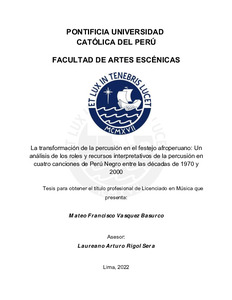| dc.contributor.advisor | Rigol Sera, Laureano Arturo | |
| dc.contributor.author | Vasquez Basurco, Mateo Francisco | |
| dc.date.accessioned | 2023-01-25T17:54:24Z | |
| dc.date.available | 2023-01-25T17:54:24Z | |
| dc.date.created | 2022 | |
| dc.date.issued | 2023-01-25 | |
| dc.identifier.uri | http://hdl.handle.net/20.500.12404/24121 | |
| dc.description.abstract | El presente trabajo de investigación se desarrolla en el campo musicológico y responde a la
escasa documentación formal relacionada con la percusión afroperuana. En ese sentido, el
objetivo principal de esta tesis es realizar un análisis rítmico y sonoro del ensamble de percusión
grabado en cuatro festejos por la agrupación Perú Negro entre las décadas de 1970 y 2000. Para
alcanzar el objetivo planteado, se trabajó el análisis musical en base a los roles y recursos
interpretativos, conceptos que se obtienen producto de la revisión bibliográfica y discográfica del
ámbito afroperuano. El trabajo se divide en dos partes: revisión del estado del arte e implicancias
históricas, y el análisis rítmico. El primero, contextualiza al lector sobre dónde y cómo se ubica
Perú Negro dentro de la línea temporal de la historia de la música afroperuana, así como los
sucesos históricos que influyeron en la sonoridad de la percusión de la agrupación en su periodo
fundacional y los años posteriores. El segundo, analiza y compara rítmicamente cuatro
canciones: “Ollita Nomá” (1973) y “El Alcatraz Quema Tú” (1974) y las versiones modernas
grabadas por la misma agrupación en los años 2000 y 2004 respectivamente. La metodología
analítica y descriptiva permite evidenciar los patrones y recursos rítmicos utilizados por el
ensamble de percusión de Perú Negro en las canciones seleccionadas, las cuales, posteriormente
son sometidas a una comparación temporal entre las décadas del 70 y 2000, en donde se
encuentran tanto convergencias como diferencias. Luego del proceso de investigación, se
concluye que la transformación sonora en dicho ensamble responde a la consolidación de nuevos
instrumentos de origen afrocubano, y al empleo de nuevos conceptos y recursos rítmicos. | es_ES |
| dc.description.abstract | The following thesis is developed within the musicological field in response of the limited
research regarding the Afroperuvian percussion. Therefore, this paper’s principal objective is to
achieve a rhythmic and sonorous analysis of the Afroperuvian percussion ensemble recorded in
four festejo songs between the decades of 1970 and 2000. In order to attain this thesis’ purpose,
the rhythmic analysis was worked through the roles and interpretative concepts obtained after the
bibliographical and discographic research of the main books and authors, as well as artists of the
Afroperuvian culture. This work is divided in two main parts: state of the art and historical
background, and the rhythmic analysis. The first one, provides the lector with the necessary
context of Peru Negro within the Afroperuvian traditions and the historical background that may
influenced sonority of the percussion ensemble on their early years and later. The second one,
rhythmically analyses and compares four songs: “Ollita Nomá” (1973) and “El Alcatraz Quema
Tú” (1974). And their new versions recorded by the same cast in the 2000 and 2004 respectively.
An analytical and descriptive methodology sets forth a deep understanding about the rhythmic
patterns and resources on the Peru Negro’s percussion ensemble used on the mentioned
recordings. Thereupon are compared through a chronological point of view, allowing to find
convergences and differences. This research concludes that the transformation of the rhythmic
and sonorous elements of this ensemble, responses to the consolidation of Afrocuban instruments
within the ensemble and the incorporation of new rhythmic concepts. The principal
accomplishment of this thesis is that it permits to visualize and understand the musical aspects
that are assimilated by the Afroperuvian percussion ensemble during its natural modernization
process. | es_ES |
| dc.language.iso | spa | es_ES |
| dc.publisher | Pontificia Universidad Católica del Perú | es_ES |
| dc.rights | info:eu-repo/semantics/openAccess | es_ES |
| dc.rights.uri | http://creativecommons.org/licenses/by/2.5/pe/ | * |
| dc.subject | Música negra--Historia--Perú--Lima | es_ES |
| dc.subject | Música de percusión--Perú | es_ES |
| dc.subject | Análisis musical | es_ES |
| dc.title | La transformación de la percusión en el festejo afroperuano : un análisis de los roles y recursos interpretativos de la percusión en cuatro canciones de Perú Negro entre las décadas de 1970 y 2000 | es_ES |
| dc.type | info:eu-repo/semantics/bachelorThesis | es_ES |
| thesis.degree.name | Licenciado en Música | es_ES |
| thesis.degree.level | Título Profesional | es_ES |
| thesis.degree.grantor | Pontificia Universidad Católica del Perú. Facultad de Artes Escénicas | es_ES |
| thesis.degree.discipline | Música | es_ES |
| renati.advisor.dni | 41584524 | |
| renati.advisor.orcid | https://orcid.org/0000-0002-2356-4808 | es_ES |
| renati.author.dni | 48544718 | |
| renati.discipline | 215426 | es_ES |
| renati.juror | Zuñiga Roncal, Alvaro Luis | es_ES |
| renati.juror | Rigol Sera, Laureano Arturo | es_ES |
| renati.juror | Vega Zavala, Cesar Humberto | es_ES |
| renati.level | https://purl.org/pe-repo/renati/level#tituloProfesional | es_ES |
| renati.type | https://purl.org/pe-repo/renati/type#tesis | es_ES |
| dc.publisher.country | PE | es_ES |
| dc.subject.ocde | https://purl.org/pe-repo/ocde/ford#6.04.04 | es_ES |






